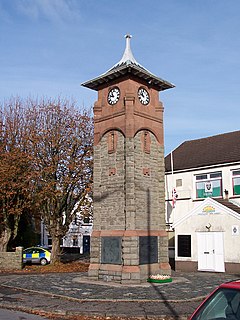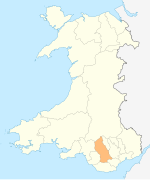Hirwaun: Difference between revisions
RjwilmsiBot (talk | contribs) m →Transport: CiteCompletion, dates: 1, works/pubs: 1, titles: 1, using AWB (8079) |
→Transport: adjust |
||
| Line 40: | Line 40: | ||
==Transport== |
==Transport== |
||
The village was originally served by the [[Vale of Neath Railway]], which arrived in 1851. |
The village was originally served by {{Stnlnk|Hirwaun}} on the [[Vale of Neath Railway]], which arrived in 1851. At Gwelli Junction north of the station, as well as the mainline from {{stnlnk|Neath}} to {{Stnlnk|Merthyr Tydfil}}, there was the VoNR branch to {{Stnlnk|Aberdare}} and the [[Aberdare Railway]]. South of the station existed the goods yard and sidings to serve the various industries in the area, including: Hirwaun Ironworks; Tower Colliery; two brickworks; Penderyn quaryy tramway. |
||
However, after the [[Beeching Axe]], in 1963 the line south to Neath, north to Merthyr and the former Aberdare Railway were all closed. Hirwaun station itself was demolished. The line north to Aberdare on the [[Merthyr Line]] to {{Stnlnk|Cardiff Central}} was only kept open for coal train traffic to Tower Colliery, which moved its [[coal washery]] and loading facility onto the site of the former station goods yard. |
|||
After the second closure of Tower in early 2008, in November 2009 the Welsh Assembly Government asked [[Network Rail]] to conduct a feasibility study on reopening the line to Hirwaun for passenger services.<ref>{{cite news| url=http://news.bbc.co.uk/1/hi/wales/8346748.stm | work=BBC News | title=Old tracks could see trains again | date=6 November 2009}}</ref> After clearing the line of vegitation, Network Rail submitted its report to WAG, who in March 2011 announced that sufficnet funds had been allowed in the 2011-12 capital programme to allow the re-opening of the line to Hirwaun as part of the Cynon Valley Scheme.<ref>http://www.walesonline.co.uk/news/local-news/aberdare/2011/03/24/aberdare-to-hirwaun-rail-line-set-to-reopen-91466-28381233/</ref> However, there is currently no information on when the work will commence and when the line will re-open. |
After the second closure of Tower in early 2008, in November 2009 the Welsh Assembly Government asked [[Network Rail]] to conduct a feasibility study on reopening the line to Hirwaun for passenger services.<ref>{{cite news| url=http://news.bbc.co.uk/1/hi/wales/8346748.stm | work=BBC News | title=Old tracks could see trains again | date=6 November 2009}}</ref> After clearing the line of vegitation, Network Rail submitted its report to WAG, who in March 2011 announced that sufficnet funds had been allowed in the 2011-12 capital programme to allow the re-opening of the line to Hirwaun as part of the Cynon Valley Scheme.<ref>http://www.walesonline.co.uk/news/local-news/aberdare/2011/03/24/aberdare-to-hirwaun-rail-line-set-to-reopen-91466-28381233/</ref> However, there is currently no information on when the work will commence and when the line will re-open. |
||
Revision as of 13:19, 21 July 2012
| Hirwaun | |
|---|---|
 Hirwaun War Memorial | |
| Population | 4,851 |
| OS grid reference | SN966055 |
| Principal area | |
| Preserved county | |
| Country | Wales |
| Sovereign state | United Kingdom |
| Post town | ABERDARE |
| Postcode district | CF44 |
| Dialling code | 01685 |
| Police | South Wales |
| Fire | South Wales |
| Ambulance | Welsh |
| UK Parliament | |
| Senedd Cymru – Welsh Parliament | |
Hirwaun (Welsh "Long Meadow") is the name of a village at the northwest end of the Cynon Valley in the County Borough of Rhondda Cynon Taf, South Wales. The village of Hirwaun is 4 miles (6.4 km) from the town of Aberdare, and comes under Aberdare for postal reasons. According to the 2001 census, Hirwaun has a population of 4,851 people.[1] The Brecon Beacons National Park lies just on the northern edge of the village.
History and Background
Hirwaun has an industrial background centring on the Hirwaun Ironworks. The ironworks was in already existence during the late 18th century and passed through a succession of owners before being purchased in 1819 by William Crawshay of Cyfarthfa, in whose family it remained until closure in 1859. The ironworks' blast furnaces required coke, which spurred an increase in local coal mining activities. Even after the ironworks closed, coal mining continued.
The Crawshay family were powerful, almost all powerful in the production of steel, and the Hirwaun Ironworks had produced cannons used on HMS Victory. The family owned a large portion of Hirwaun and even used their own money to pay employees by th "Hirwaun Guinea", there by stopping employees travelling to Cardiff or spending their money outside the controlled economy of the village.[2]
Following the miners' strike, however, the only deep coal mine left in Wales was Tower Colliery, which closed down, was bought by its workers and reopened.
Architecture
Unlike most South Wales Coalfield villages, Hirwaun consists of a vast array of different architectural housing styles, often cheek-by-jowl in small blocks. This is due to development to satisfy different needs at different times, with much gentrification taking place in the last few decades. Hirwaun hence has a discontinuous, hotch-potch feel to it that marks it out as unusual in the South Wales Valleys.
St Lleurwg's Church
Saint Lleurwg's parish church is situated in the centre if the village and is part of the ecclesiastical Parish of Hirwaun. It was opened by the Bishop of Llandaff in July 1858. The sister church in the parish is dedicated to Saint Winefred and is in Penywaun.
The tower blocks
Hirwaun made local news in May 2004 when its two 1960s built tower blocks were demolished by dynamite detonation. Their demise marked the end of a major landmark in the Cynon Valley.
Hirwaun Common development
Currently the patch of green land known as Hirwaun Common is being built on, a development of modern family homes being built.
Transport
The village was originally served by Hirwaun on the Vale of Neath Railway, which arrived in 1851. At Gwelli Junction north of the station, as well as the mainline from Neath to Merthyr Tydfil, there was the VoNR branch to Aberdare and the Aberdare Railway. South of the station existed the goods yard and sidings to serve the various industries in the area, including: Hirwaun Ironworks; Tower Colliery; two brickworks; Penderyn quaryy tramway.
However, after the Beeching Axe, in 1963 the line south to Neath, north to Merthyr and the former Aberdare Railway were all closed. Hirwaun station itself was demolished. The line north to Aberdare on the Merthyr Line to Cardiff Central was only kept open for coal train traffic to Tower Colliery, which moved its coal washery and loading facility onto the site of the former station goods yard.
After the second closure of Tower in early 2008, in November 2009 the Welsh Assembly Government asked Network Rail to conduct a feasibility study on reopening the line to Hirwaun for passenger services.[3] After clearing the line of vegitation, Network Rail submitted its report to WAG, who in March 2011 announced that sufficnet funds had been allowed in the 2011-12 capital programme to allow the re-opening of the line to Hirwaun as part of the Cynon Valley Scheme.[4] However, there is currently no information on when the work will commence and when the line will re-open.
Sport
Hirwaun RFC currently play in the SWALEC League 5 South Central. Hirwaun also have a number of football teams Hirwaun & Mackworth FC, Lamb FC, Glancynon FC and PT Civils. Hirwaun & Mackworth (formally Hirwaun Welfare) are currently the highest ranked team playing South Wales Amateur Football League D2. The Lamb FC, Glancynon FC, PT Civils and Hirwaun & Mackworth seconds play in the Heatwise Aberdare Valley Football League.
Notable people
- See also Category:People from Hirwaun
References
- ^ Davies, John (2008). The Welsh Academy Encyclopaedia of Wales. Cardiff: University of Wales Press. p. 369. ISBN 978-0-7083-1953-6.
{{cite book}}: Unknown parameter|coauthors=ignored (|author=suggested) (help) - ^ Cyfarthfa Ironworks Old Merthyr Tydfil
- ^ "Old tracks could see trains again". BBC News. 6 November 2009.
- ^ http://www.walesonline.co.uk/news/local-news/aberdare/2011/03/24/aberdare-to-hirwaun-rail-line-set-to-reopen-91466-28381233/

